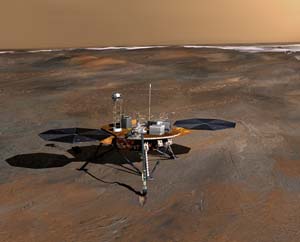Since a stunningly successful landing of the Phoenix Mars Lander on May 25, mission researchers centered at the University of Arizona have rolled up their sleeves and commanded the Lander to find soil and ice samples and are taking and analyzing pictures from the Red Planet’s frigid northern hemisphere.
Among those Mission workers are the WUSTL chair of earth and planetary sciences, a computer specialist and four WUSTL students.

Their goal is to infer from images and other data the geological history of the landing site and to imply some theories about current and past climate on Mars.
Raymond E. Arvidson Ph.D., the James S. McDonnell Distinguished University Professor and chair of the earth and planetary sciences department in Arts & Sciences at Washington University in St. Louis, has extensive experience in planetary landing operations.
He participated in the two Viking Lander missions in 1976 and helped select the landing site for the 2004 Mars Exploration Rover (MER) mission, and then guided the activities of the rovers Spirit and Opportunity as the mission’s deputy principal investigator. Accordingly, Arvidson is NASA’s Phoenix landing site working group chairman. He also is co-investigator for the Phoenix robotic arm (a crucial instrument that will gather the soil and ice samples), is the lead for archiving mission data and was a key science lead for operations in the first week of the mission, a critical time.
The primary mission is brief, just 90 days.
A week after landing, the Phoenix Mars Lander took its first scoop of Martian soil to test the robotic arm and passed with flying colors.
According to Arvidson, the researchers will test and analyze soil samples using an array of sophisticated instruments and perform trenching operations to dig down to ice with soil sampling over the next few weeks. They will continue imaging the surface and perform sky and weather station measurements.
”Dig Czar”
“I am now the ‘dig czar’, helping organize the science team’s desires for digging and sampling with the robotic arm,” Arvidson said. “So, I manage the excavations with the backhoe mode of the scoop and the ice rasp.”
Accompanying Arvidson at the University of Arizona are spring 2008 WUSTL graduate Tabatha Heet, WUSTL doctoral candidate Selby Cull and sophomore Kirsten Siebach and junior Rebecca Greenberger, both of whom are Fossett Fellows in a scholarship program established at WUSTL by the late adventurer J. Stephen Fossett. Thomas C. Stein, a WUSTL computer systems manager, is working with the Phoenix geology theme group and also archiving data for NASA’s Planetary Data System.
The four students are Phoenix Mission documentarians, responsible for recording all that is done on the mission and for naming geological sites in the area after fairy tale and nursery rhyme characters. Early names are “Humpty Dumpty” and “Alice.”
Heet played a key role in counting rocks to enable a safe landing area using HiRISE, a feature of the Mars Reconnaissance Orbiter, which permits the viewing of rocks on Mars as small as roughly a yard and a half across, and ENVI, a software package that displays images and makes measurements. She began the rock measurement and counting project in October 2006, when she was a junior, and in the fall will begin graduate studies at WUSTL, basing much of her work on Phoenix Mars Mission data.
“Landing Day was extremely exciting, especially when we got confirmation that Phoenix was on the ground and saw those first images of the open solar arrays,” said Heet. “As documentarians, we are in charge of recording all of the important aspects of planning and executing each sol (a Martian day).
“Scientists are good at coming up with great ideas, but somebody has to write them down or they get forgotten in the excitement of the day. We also record possible science activities for each sol and the rational behind wanting to carry out each of these activities. This is useful for prioritizing activities each day and will be a good way for future scientists to ‘walk through’ the mission and understand our goals and how we attempted to accomplish them.”